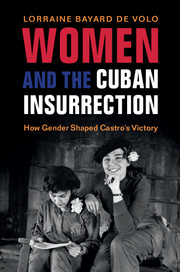Book contents
- Women and the Cuban Insurrection
- Women and the Cuban Insurrection
- Copyright page
- Dedication
- Contents
- Preface
- 1 Revolution Retold
- 2 “How Can Men Tire When Women Are Tireless?”
- 3 A Movement Is Born
- 4 Abeyance and Resurgence
- 5 Gendered Rebels
- 6 War Stories Celebrated and Silenced
- 7 “Stop the Murders of Our Children”
- 8 Masculinity and the Guerrilla War of Ideas
- 9 Women Noncombatants
- 10 Las Marianas
- 11 Past Is Prologue
- Bibliography
- Index
10 - Las Marianas: Even the Women in Arms
Published online by Cambridge University Press: 19 January 2018
- Women and the Cuban Insurrection
- Women and the Cuban Insurrection
- Copyright page
- Dedication
- Contents
- Preface
- 1 Revolution Retold
- 2 “How Can Men Tire When Women Are Tireless?”
- 3 A Movement Is Born
- 4 Abeyance and Resurgence
- 5 Gendered Rebels
- 6 War Stories Celebrated and Silenced
- 7 “Stop the Murders of Our Children”
- 8 Masculinity and the Guerrilla War of Ideas
- 9 Women Noncombatants
- 10 Las Marianas
- 11 Past Is Prologue
- Bibliography
- Index
Summary
On September 4, 1958, Fidel christened the all-women's platoon “Mariana Grajales” in honor of the Afro-Cuban woman heroine of the independence wars and mother of the heroic Maceo brothers. The Mariana Grajales Platoon (Las Marianas) is well known, having received coverage both domestically and internationally. But the Marianas numbered at most fourteen, engaged in only a limited number of battles in the last months of the insurrection, and did not make a discernible difference to the outcome of a battle. Gender research on war tells us that all-women's units such as Las Marianas are extremely rare cases in the history of warfare, which tend to form in response to extreme military personnel shortages or as the nation faces an existential threat. However, the formation of Las Marianas was not a decision made by a desperate military suffering severe attrition but rather an increasingly successful one with more volunteer combatants than it could put to use. Furthermore, Cuban guerrilla men's initial opposition to arming women is well documented. Why, then, did the guerrilla leadership make this unusual, initially unpopular, and militarily unnecessary decision to arm women?
Though the Marianas proved effective combatants, I propose that the platoon's formation is not sufficiently explained by its potential contribution to guerrilla battlefield effectiveness. The Marianas represented a small fraction of the guerrillas' already small fighting force, a detail easily lost given the considerable attention they receive in the Cuban War Story. Nearly all instances of guerrilla women in combat occurred in the last six months of the insurrection, by which time the tide had turned in the rebels' favor. By July 1958, the US embassy and state department, for example, considered M-26-7 victory a real possibility. Guerrilla confidence, too, was higher following the military's failed 1958 Summer Offensive, and Fidel was contemplating the postwar period. Accordingly, rather than contributions to fighting effectiveness, the Marianas formation is best explained by the convergence of four factors: the symbolic power of such a platoon, M-26-7's official ideological commitment to ending discrimination, pressure from women who sought combat, and an increase in available rifles. Of these, the driving cause was the symbolic effect of armed women.
- Type
- Chapter
- Information
- Women and the Cuban InsurrectionHow Gender Shaped Castro's Victory, pp. 210 - 234Publisher: Cambridge University PressPrint publication year: 2018

